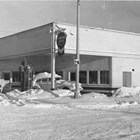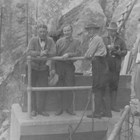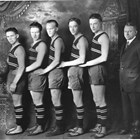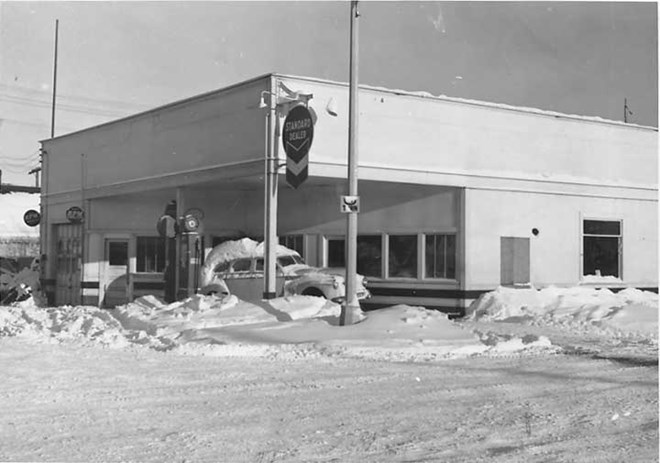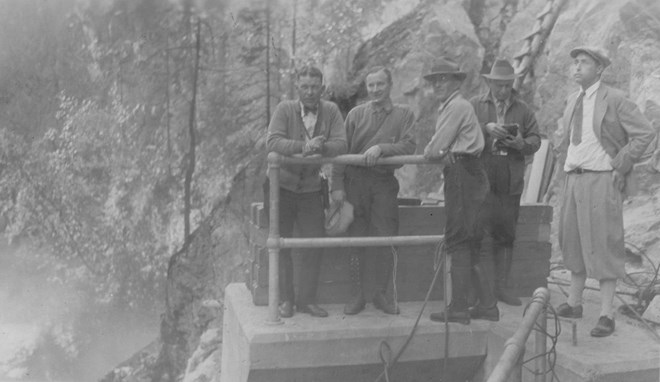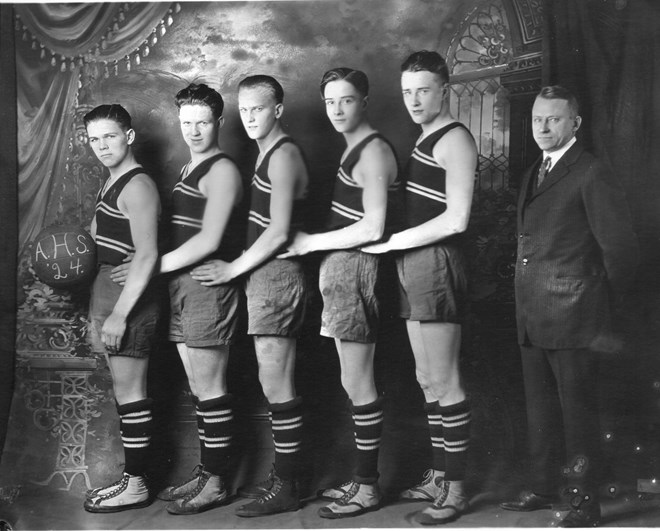Gill, Oscar S.
1880-1947 | Business Owner, City Councilman, Mayor of Anchorage (1932-1933, and 1934-1936), and Territorial Legislator (1944-1947)
Oscar S. Gill was a dedicated and respected Anchorage public servant. From the 1920s to the 1940s, he served four years on the school board (1921-1924), three years on the city council (1929-1932), and as Mayor of Anchorage for three terms (1932-1933 and 1934-1936). He was a member of the Alaska Territorial House of Representatives for two terms (1944-November 18, 1947), representing the Third Division. He became Speaker of the House in 1947, just prior to his death. In 2003, the Cook Inlet Historical Society placed a plaque on his grave which reads: “In Recognition of Exemplary Community Service.” The Anchorage Daily Times, with Robert Atwood as editor, eulogized Gill as “an upright citizen, a sturdy character and loyal friend.”1
In a 1987 Anchorage Times article, historian Stephen Haycox said that Gill made the best of a bad situation as Depression-era mayor: "When Anchorage is a much larger city, and much more is done to acknowledge the contribution made by early residents and leaders to establishing the foundations of the original town, one who will be widely recognized will be Oscar S. Gill, Anchorage’s mayor for three 12-month terms, 1932-33, 1934-35, and 1935-36. . . . But his depression-era service to the city was especially thoughtful, effective and sensitive. His efforts on behalf of Anchorage deserve wider understanding."2
Pennsylvania to Alaska
Oscar Stephen Gill was born, one of a set of twins, in St. Lawrence, Pennsylvania on April 3, 1880 to Samuel and Lydia Wagner Gill.3 He attended school through the eighth grade.4 As a young man he moved to join his mother’s sister in Portsmouth, Iowa, where he worked carrying the mail. According to the Gill family, he also played in the Portsmouth German cornet band. In 1900, he was working as a farm laborer in Washington Township in Shelby County, Iowa.5
On September 6, 1905 he married Emma Christine Dohrmann in Potawattamie, Iowa, near Council Bluffs. The couple moved to Anacortes, Washington, where their first son, Victor, was born in 1906.6
In 1907, Oscar and Emma Gill moved to Seward, Alaska, where Oscar worked for Samuel M. Graff, a prominent local businessman and lawyer who operated the local power plant and telephone exchange.7 That same year a second son, William, was born. Oscar also played baseball on Seward’s Branch baseball team.8
In 1909, Gill moved to Susitna Station, a community approximately thirty miles up the Susitna River from Cook Inlet. He operated a sawmill that provided lumber for settlements on the west side of Cook Inlet. In 1910 the Gill household included Emma Gill’s widowed father, Henry Dohrmann, her brother, Henry C. Dohrmann, as well as Oscar’s brother Hilary Gill.9 A third son, Phillip, was born to Oscar and Emma that same year.
In 1912, Gill returned to Seward where their fourth child, Louise, was born. In 1914, Gill had a contract with the Northern Commercial Company to move freight and mail by dog team in the winter between Seward and Knik, possibly as far as Iditarod, on the Seward-Iditarod trail.10 He prospected briefly at Eklutna and Clear Creek. The discovery of gold in Iditarod and Innoko led Gill to move to Knik at the head of Cook Inlet where he built a two-story house in Knik in 1913.11 By 1915, if not earlier, Oscar Gill and his father-in-law, Henry Dohrmann, were proprietors of the Susitna Saw Mill Company.12
While living on the west side of Cook Inlet, Gill also worked as an engineer for “Red" or "Jack” Bartels on the Sea Lion, a small gasoline powered boat that carried freight and passengers on Cook Inlet. The Sea Lion was later purchased by Nick Gaikema, another prominent early Anchorage resident who was well known for using the boat to take groups of Anchorage residents across the inlet in the fall to hunt ducks. In later years Gill would be one of Gaikema’s passengers on these duck hunting (and poker playing) excursions. These small boats were nicknamed the “mosquito fleet” and were important for moving passengers and freight to the small settlements and homesteaders of Cook Inlet.13
Business Career in Anchorage
Gill rushed to Anchorage in 1915 when it was still a tent city named Ship Creek. President Woodrow Wilson announced in April 1915 the selection of the so-called western or Susitna route for a federal railroad for Alaska, running from Seward (a year-round ice-free port on tidewater) to Fairbanks. As early as February 1915, speculation that work would soon begin on constructing a line between Ship Creek and the Matanuska coal fields caused hundreds to move to the area. This set off a stampede in March 1915 to the creek flats, which became the site of a tent city. In June 1915, the townsite had more than two thousand people.14
The Alaskan Engineering Commission (AEC) was formed to supervise construction of the main line of the Alaska Railroad from its southern terminus at Seward, thorough Anchorage, and to Fairbanks in the interior—470.3 miles. The Alaska Railroad was the only railroad built with federal support to stimulate settlement and economically develop a territory along a railroad route, at a level of federal support surpassing other western territories.15
Like other hopefuls, Gill rushed to Ship Creek in 1915 to work on railroad construction. According to Evangeline Atwood, Gill “is said to have met the first boat that came to Anchorage to unload construction supplies for building the [Alaska] railroad. He owned a small boat and carried freight to the thriving community of Knik, from the large ships which anchored off Ship Creek flats, where the present townsite of Anchorage was nothing but brush and swamps.”16 Until a dock was built,17 small boats like those owned by Gill and Gaikema would shuttle freight and passengers from the oceangoing ships to shore.
Gill went into business running a lighterage service under contract with the AEC in 1916. By 1918, he was working for the AEC as a crane operator.18 According to local historian John Bagoy, Gill also worked as an engineer on the mosquito fleet boats during the family’s early years in Anchorage.19
The South Addition, along with the East Addition, were added to the Anchorage townsite in 1916. The South Addition was the area located south of Ninth Avenue and included the string of blocks along what is now known as the Delaney Park Strip. The South Addition was Anchorage’s first subdivision. Gill moved his Knik house by barge up the Inlet, and then hauled it to 918 West 10th Avenue, where it stood exactly on its original site until 1982. To prevent its demolition, due to the expansion of the Anchorage Pioneer Home, the house was moved and, in 1993, returned to its former neighborhood, less than four blocks from its historic location.20
In 1923, Gill opened Anchorage’s first garage and repair shop, Gill’s Garage, at the corner of 4th and I Street, which kept him busy for much of the remainder of his life. This station functioned as a full automobile repair and service facility. In 1924, he fabricated a special fuel tank for Noel Wien’s first flight from Anchorage to Fairbanks on July 3, 1924.21
Public Service
Gill’s public service began in 1921 with his election to the Anchorage School Board. He received 76 out of 77 votes at a special election on February 16, 1921.22 He was re-elected to a second term, 1921-1923, and to a third term, 1923-1924. He served as the board’s clerk from 1921 to 1924.23
As a member of the school board, Gill appeared before the Anchorage City Council on several occasions. On August 1, 1923, he requested funds so that “fittings” could be installed for the Anchorage Public School’s heating plant.24 Gill reported on school overcrowding at the city council’s meeting on February 20, 1924. The Anchorage City Council appointed a committee of its members to look into the situation.25 On September 10, 1924, he asked for a $5,000 loan from the city, until the quarterly installment of Territorial funding to meet salaries and other expenses was received. He also spoke again about the crowded school situation and the need to hire another teacher, which the city council approved.26 On January 6, 1926, the city council voted to appoint Gill, who had completed his term on the school board, to finish Dr. J.B. Beeson’s term as board president.27
In the 1920s, Gill became involved with the Western Alaska Fair Association. He served as chairman of the grounds and buildings committee and was involved in the purchase of Austin E. “Cap” Lathrop’s former studio, a large building built at the end of Third Avenue for the filming of The Chechakos (1924). This building, which came to be known as the Community Building, had served as the fair’s main building in 1924 and 1925. When the building was purchased in July 1926, the Western Alaska Fair Association had already spent several thousand dollars modifying and improving it.28 He was a director of the Western Alaska Fair Association in 1926, appointed as treasurer in 1927 and, again in 1930, the year of the last fair.29
Gill served on three terms on the Anchorage City Council from 1929 to 1932. In 1929, he was elected to a one-year term to replace C.A. Pollard. In 1930, he was elected to a two-year term, serving until 1932, when he was elected mayor of Anchorage. He did not stand for election in 1933. He ran for a second, non-consecutive, term in 1934, and was unopposed for election. He was re-elected twice, to one-year terms, and served as mayor from 1934 to 1936.30 His son, Victor Gill, made an unsuccessful bid to succeed him as mayor of Anchorage in 1936.
Great Depression in Anchorage and Service as Mayor
Gill was mayor during some of the most difficult days of the Great Depression. A 1987 Anchorage Times article by historian Stephen Haycox described the unemployment situation in 1933: "As in other parts of the country, there simply were not enough jobs. Early in the summer of 1933 the town’s jobless held a mass meeting to articulate and dramatize their plight. Three hundred people attended, significant for a little town of not quite 2,000 residents. Later, a house-by-house canvass was conducted by the Anchorage Chamber of Commerce to get an accurate count of the unemployed. Of 300 so declared, it was considered significant that 51 were married men."31
As the Depression deepened, Alaska received funds from President Franklin D. Roosevelt’s New Deal. However, because Alaska was a territory and not a state, its share of federal funds and programs was usually small.32 Gill took advantage of programs that provided funds for projects that generated employment. Gill worked well with the Alaska Territorial Governor John W. Troy and Congressional Delegate Anthony Dimond to receive federal funds and address the needs of the city. Temporary jobs were created in the summer of 1933 and succeeding summers for a number of jobless men using federal monies from the Public Works Administration (PWA) and Federal Emergency Relief Administration (FERA).33 The highlight of Gill’s tenure was the securing of Public Works Administration funds to build a city hall. This was an imposing first-class concrete structure, “far and away the biggest and best in the city.” In 1936, the Anchorage City Hall (524 West Fourth Avenue) included the mayor’s office, clerk’s office, city council chambers, all municipal offices, the library, telephone switchboard, and three jail cells. There was a “drunk tank” in the basement. There was a small caretaker apartment for the janitor and jailer and firefighter’s quarters. In addition, Gill received federal funds through the governor’s office to pave the city’s main streets for the first time, and to install new street lights.34
During Gill’s three terms as mayor, a three-member Anchorage Aeronautics Commission was established to manage the city airport, Merrill Field. The city council appointed Gill himself to fill a vacancy on the Commission near the end of his third term as mayor. Among the tasks of the Commission was to review the possibility of establishing a seaplane base at the mouth of Chester Creek (now Westchester Lagoon), to be called Lake Ohlson after Otto Ohlson, the general manager of the Alaska Railroad. Local landowners protested this idea and the Commission then looked at building a base near Merrill Field.35 The seaplane base was finally built at Lake Hood and Lake Spenard, connected by a specially dredged channel.
Although the City of Anchorage had a lease with the federal government for Merrill Field, the city council directed Gill to contact Territorial Governor George Parks to intercede on Anchorage’s behalf to obtain the right to purchase and own the airfield outright.36 The city also sought to purchase the land around Lake Spenard for recreational purposes.37
A continuing problem before the city council and mayor was the disruption of local radio station KFQD’s signal due to electrical interference.38 On December 21, 1932, the city council approved an ordinance forbidding use of any device that would interfere with the radio signal, and required the city electrician to make a survey to find any such devices. The city would help pay for the filters that would alleviate problems when found.39
As a member of the city council and, later, as mayor, Gill dealt with requests for improvements to the sewer system, more street lights, and to repair or replace sidewalks. Ordinances regulating the Anchorage Memorial Park Cemetery, levying taxes, public health issues, employee relations, and itinerant peddlers were passed while he was in office.40
In 1930, the city council oversaw the construction of Anchorage High School on the south side of the school reserve and dedicated the new municipal airport, Merrill Field. To the old problem of children riding their bikes on downtown sidewalks, the city council now forbade children on roller skates in summer and on sleds in winter.41
To the “kids of Anchorage,” Gill had an open invitation to roller skate on the sidewalks around his garage. This invitation was extended at a time when roller skating had brought complaints before the city council. His warm friendships with children led him to purchase a fleet of bicycles and “extend his garage business in that direction to meet a community need.”42
A long-sought goal of the city council had been to purchase, and thereby control, the electrical and telephone distribution system in Anchorage, which was owned by the Alaska Railroad. The city council had pursued the purchase of these systems since the administration of Mayor Charles Bush in 1925. Gill was one of the leaders on the city council that continued to pursue the purchase. A deal approved by the city council under Mayor James Delaney in November 1931, had fallen through at the last moment, although a referendum before the voters in April 1932 regarding the purchase of the system had passed overwhelmingly. Late in 1932, the Alaska Railroad indicated its interest in making the sale. The city council authorized Gill to finalize the sale on the terms of a resolution passed on November 11, 1931. Alaska Railroad General Manager Otto Ohlson agreed to the proposed terms on January 18, 1933, and Anchorage finally became the owner of its electrical and telephone system. After Gill’s death in 1947, the Anchorage Times described the purchase’s long-term significance: "In the early days of the city he figured in one of the big decisions made by the city council. The result of that decision guided the course for financing municipal activities down to the present and far into the future. It was the decision to buy the electrical distribution system from the Alaska Railroad. It was a major investment of public funds. There was widespread debate. Many local residents considered it a poor investment, predicting that Anchorage would prove only a boom camp resulting from construction activities on the railroad . . . . Oscar Gill was one of the leaders of the move to purchase. His endeavors were successful. He helped set the pattern under which the city for many years collected the major portion of its revenues from electricity while keeping property taxes low."43
Gill, a Republican, served in the Alaska Territorial House of Representatives from 1944 until 1947. He was first elected in 1944, and was re-elected in 1946, becoming Speaker of the House in 1947. He died while still in office, November 18, 1947.
In civic affairs, Gill was a charter member of the Elks, joining in 1919 and becoming their exalted ruler twice. He was addressing the Elks Club when he collapsed and died of a heart attack on the evening of November 18, 1947.44
Due to Gill’s prominence in the Anchorage community, many businesses closed during his funeral. The Anchorage Daily Times reported that it was one of the largest funerals in Anchorage in many years.45 Father Dermot O’Flanagan, the priest at Holy Family Church, presented the eulogy. Exalted Ruler Louis Odsather, representing the Elks, presided at the funeral. His widow, Emma Christine Dohrmann Gill, died on March 30, 1974. The couple is interred in the Anchorage Memorial Park Cemetery.46
The Oscar Gill House is only one of a handful of residences built or moved in Anchorage in the years 1915-1917, which still stand. In 1994, it was restored and moved to a new location at 1344 West 10th Avenue. It houses a bed and breakfast boardinghouse. In 2001, the Oscar Gill House was added to the National Register of Historic Places.47
Endnotes
- “His Work Will Endure,” Anchorage Daily Times, November 20, 1947, 2.
- Stephen Haycox, “Depression-era mayor made best of a bad situation,” Anchorage Times, July 19, 1987, B-1.
- Christine Marie Gill, “Oscar S. Gill,” April 1999, 1-4, File: Gill, Oscar; Bagoy Family Pioneer Files (2004.11), Box 3, Atwood Resource Center, Anchorage Museum at Rasmuson Center, Anchorage, AK.
- Oscar Gill, U.S. 1940 Census, Anchorage, Third Judicial Division, Alaska, National Archives Microfilm Publication T627, Sixteenth Census of the United States, 1940, Roll 4580, ED 3-21, page 39A, 1940 United States Federal Census [database on-line]; http://ancestry.com (accessed February 17, 2015).
- Oscar Gill, U.S. 1900 Census, Washington, Shelby County, Iowa, ED 178, page 7A, National Archives Microfilm Publication T623, Twelfth Census of the United States, 1900, Roll 459, 1900 United States Federal Census [database on-line], http://ancestry.com (accessed February 19, 2015).
- Marriage Record, Oscar S. Gill and Emma Dohrmann, September 6, 1905, Iowa Department of Public Health, Iowa Marriage Records, 1880-1922, microfilm, RG 048, State Historical Society of Iowa, Des Moines, IA, Marriage Records, 1880-1937 [database on-line], http;//ancestry.com (accessed July 28, 2016); and Christine Gill, “Oscar S. Gill,” 1, File: Gill, Oscar; Bagoy Family Pioneer Files (2004.11), Box 3; Atwood Resource Center, Anchorage Museum at Rasmuson Center, Anchorage, AK.
- Mary J. Barry, Seward, Alaska: A History of the Gateway City, Volume I, Prehistory to 1914 (Anchorage: Mary J. Barry, 1986), 77 and 93.
- The Branch team played their home games at Branch Park (the baseball field) in Seward. Gill also was on the Seward team that played the Valdez team on the Fourth of July, 1908. Mary J. Barry, Seward, Alaska: A History of the Gateway City, Volume 1, Prehistory to 1914, 114.
- Oscar Gill, U.S. 1910 Census, Susitna, Cook Inlet, Division 3, Alaska Territory, ED 5, page 8A, National Archives Microfilm Publication T624, Thirteenth Census of the United States, 1910, Roll 1750, 1910 United States Federal Census [database on-line], http://ancestry.com (accessed February 19, 2015).
- Mary J. Barry, Seward, Alaska: A History of the Gateway City, Volume 1, Prehistory to 1914, 114 and 156-157.
- Christine Gill, “Oscar S. Gill,” 1, File: Gill, Oscar; Bagoy Family Pioneer Files (2004.11), Box 3; Atwood Resource Center, Anchorage Museum at Rasmuson Center.
- R. L. Polk & Company, Alaska-Yukon Gazetteer & Business Directory, 1915-16 (Seattle, WA: R.L. Polk & Company, 1916), 504.
- John P. Bagoy, Legends & Legacies, Anchorage 1910-1935 (Anchorage: Publications Consultants, 2001), 123.
- Claus-M. Naske and L.J. Rowinski, Anchorage: A Pictorial History (Norfolk, VA: Donning Company, Publishers, 1981), 41; and “Oscar Gill House,” National Register of Historic Places Registration Form, AHRS No. ANC-00412, February 2, 2001, 7; National Register of Historic Places, http://focus.nps.gov/pdfhost/docs/nrhp/text /01000022.pdf (accessed September 7, 2015).
- Stephen Haycox, Alaska: An American Colony (Seattle: University of Washington Press, 2002), 231.
- Evangeline Atwood, Anchorage, All-America City (Portland, OR: Binfords & Mort, 1957), 49.
- “Port activities date back to 1915 when the Lathrop Dock was constructed to meet the needs of the newly founded city of Anchorage at the head of the Cook Inlet.” See, “Port History,” Port of Anchorage, http://www.portofanc.com/about/history.html (accessed September 7, 2015).
- Draft Registration Card, Oscar Gill, Local Board No. 10, Anchorage, AK, October 16, 1918, National Archives Microfilm Publication M1509, Selective Service System, World War I Selective Service System Draft Registration Cards, 1917-1918, Roll 1473296, U.S., World War I Draft Registration Cards, 1917-1918 [database on-line], http://ancestry.com (accessed February 16, 2015).
- John P. Bagoy, Legends & Legacies, Anchorage 1910-1935, 123. Bagoy may have received this information from Christine Marie Gill’s notes about her grandfather, entitled “Oscar S. Gill,” compiled in April 1999, and sent to Bagoy. Her notes are deposited in the Bagoy Family Pioneer Files (2004.11), Box 3, Atwood Resource Center, Anchorage Museum at Rasmuson Center, Anchorage, AK.
- “Oscar Gill House,” National Register of Historic Places Registration Form, AHRS No. ANC-00412, February 2, 2001, 7, National Register of Historic Places; and “The Oscar Gill House: History,” Oscar Gill House, http://www.oscargill.com/history.html (accessed September 7, 2015).
- Christine Marie Gill, “Oscar S. Gill,” 1, File: Gill, Oscar; Bagoy Family Pioneer Files (2004.11), Box 3; Atwood Resource Center, Anchorage Museum at Rasmuson Center, Anchorage, AK; Michael Carberry and Donna Lane, Patterns of the Past: An Inventory of Anchorage’s Historic Resources (Anchorage: Community Planning Department, Municipality of Anchorage, 1986), 82; and Mary J. Barry, Seward, Alaska: A History of the Gateway City, Volume 1, Prehistory to 1914, 114.
- Minutes of the Anchorage City Council, February 16, 1921, in Anchorage City Council Minutes, Volumes I and II, November 26, 1920-May 27, 1933 (microfilm edition), Alaska Collection, Z.J. Loussac Library, Anchorage Public Library, Anchorage, AK.
- Helve Enatti, “Anchorage Public Schools, 1915-1951: A Thirty-Six Year School District Development Study,” (master's thesis, University of Alaska, May 1967), 355.
- Minutes of the Anchorage City Council, August 1, 1923.
- Minutes of the Anchorage City Council, February 20, 1924.
- Minutes of the Anchorage City Council, September 10, 1924; and Helve Enatti, “Anchorage Public Schools, 1915-1951: A Thirty-Six Year School District Development Study,” 45-46.
- Minutes of the Anchorage City Council, January 6, 1926.
- “Fair Directors Buy Studio for Annual Exhibit,” Anchorage Daily Times, July 13, 1926, 1.
- See “Official Premium List” of the Western Alaska Fair Association, for 1926, 1927, and 1930, File: Western Alaska Fair Association publications, 1924-1930, Ephemera Files (EPH-0046), Archives and Special Collections, Consortium Library, University of Alaska Anchorage.
- See "History of Mayors and Assembly Members, 1925-1985 [Record of Mayors and Councilmen of the City of Anchorage, Alaska]," Clerk’s Office, Municipality of Anchorage, Anchorage, AK.
- Stephen Haycox, “Depression-era mayor made best of a bad situation,” Anchorage Times, July 19, 1987, B-1.
- Claus-M. Naske, Anchorage: A Pictorial History, 106-107.
- Stephen Haycox, “Depression-era mayor made best of a bad situation,” Anchorage Times, July 19, 1987, B-1.
- Stephen Haycox, “Depression-era mayor made best of a bad situation,” Anchorage Times, July 19, 1987, B-1; and Michael Carberry and Donna Lane, Patterns of the Past: An Inventory of Anchorage’s Historic Resources, 89-90.
- Minutes of the Anchorage City Council, June 15, 1932.
- Minutes of the Anchorage City Council, July 7, 1932.
- Minutes of the Anchorage City Council, July 21, 1932.
- Minutes of the Anchorage City Council, March 19, 1930, August 20, 1930, and February 18, 1931.
- Minutes of the Anchorage City Council, December 21, 1932 and January 4, 1933.
- Minutes of the Anchorage City Council, July 3, 1929 (cemetery); Minutes, January 2, 1930 (levying taxes); Minutes, December 16, 1932 (public health); Minutes, March 16, 1932 (employee relations); and Minutes, February 4, 1931 (itinerant peddlers).
- Minutes of the Anchorage City Council, December 5, 1934, in Anchorage City Council Minutes, Volumes III and IV, June 7, 1933-April 16, 1941 (microfilm edition), Alaska Collection, Z.J. Loussac Library, Anchorage Public Library, Anchorage, AK.
- “His Work Will Endure,” Anchorage Daily Times, November 20, 1947, 2.
- Ibid.
- “Oscar Gill, 67, Former Mayor, Succumbs Here,” Anchorage Daily Times, November 19, 1947, 1.
- “Many Pay Last Respects to Oscar S. Gill,” Anchorage Daily Times, November 21, 1947, 1.
- Entries for Oscar Stephen Gill and Emma Christine Dohrmann Gill, Find A Grave Memorial; http://ancestry.com (accessed September 7, 2015); and “Heart Attack Takes Prominent Anchorage Resident Gill,” Alaska Weekly (Seattle, WA), November 28, 1947, 1.
- The other houses are the Oscar Anderson House (420 M Street), James Allenbaugh House (Second Avenue), and the Leopold David House (605 West Second Avenue).
Sources
This entry originally appeared in John Bagoy’s Legends & Legacies, Anchorage, 1910-1935 (Anchorage: Publications Consultants, 2001), 123-124. See also Oscar Gill file, Bagoy Family Pioneer Files (2004.11), Box 3, Atwood Resource Center, Anchorage Museum at Rasmuson Center, Anchorage, AK. Note: revised, updated, and substantially expanded by Bruce Parham and Walter Van Horn, September 7, 2015.
Preferred citation: Bruce Parham and Walter Van Horn, “Gill, Oscar S.,” Cook Inlet Historical Society, Legends & Legacies, Anchorage, 1910-1940, http://www.alaskahistory.org.
Major support for Legends & Legacies, Anchorage, 1910-1940, provided by: Anchorage Museum at Rasmuson Center, Atwood Foundation, Cook Inlet Historical Society, and the Rasmuson Foundation. This educational resource is provided by the Cook Inlet Historical Society, a 501 (c) (3) tax-exempt association. Contact us at the Cook Inlet Historical Society, by mail at Cook Inlet Historical Society, Anchorage Museum at Rasmuson Center, 625 C Street, Anchorage, AK 99501 or through the Cook Inlet Historical Society website, www.cookinlethistory.org.
